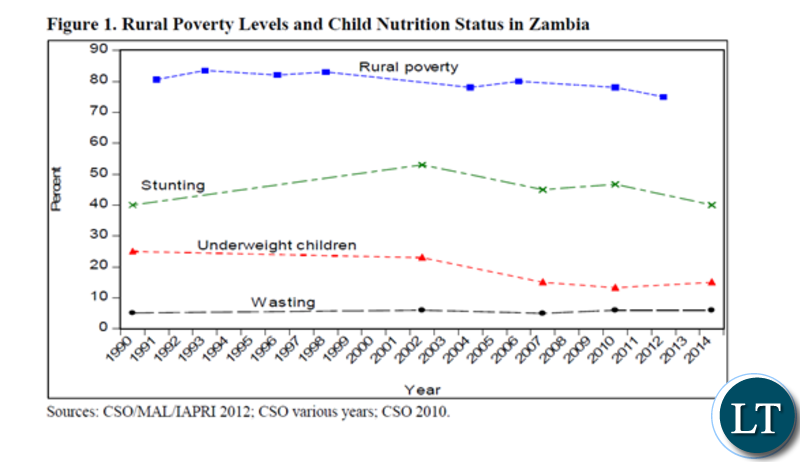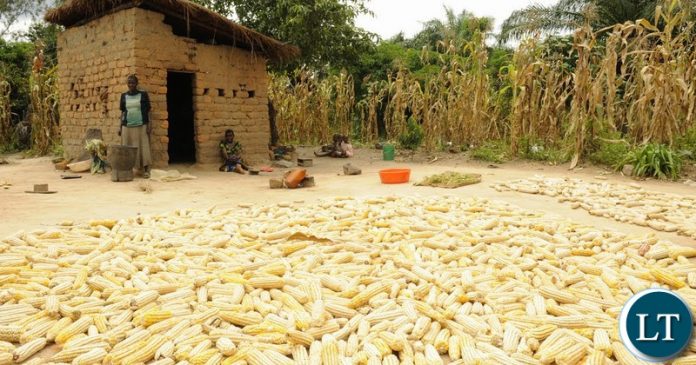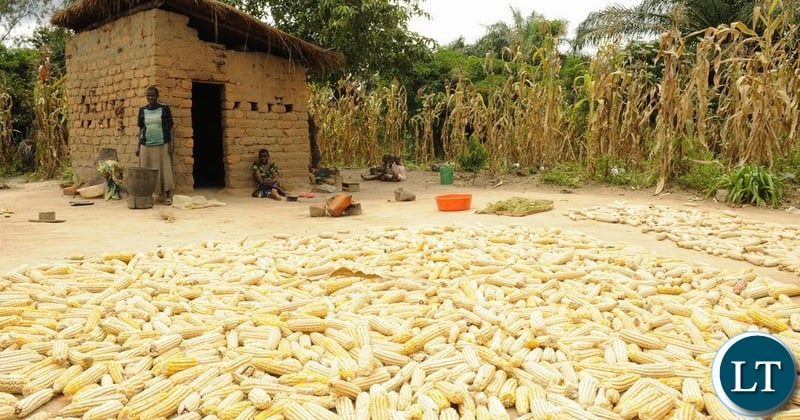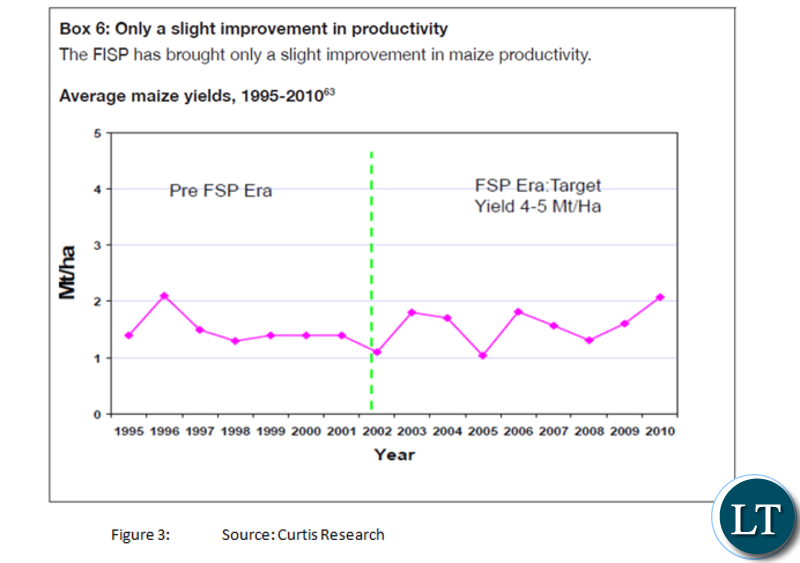Introduction
One of the most common proverbs in Zambia, says “Umwana ashenda atasha nyina ukunaya
Ubwali” which loosely translates as “A child who does not visit, thinks it’s mother is the best cook (of
nshima)”. The interesting thing about this proverb, is not what it says, but the metaphor it uses for food, which is nshima a product of maize and in effect maize. It is often said in Zambia, that people do not consider that they have had a meal for the day unless they have eaten a meal made out of maize “.
Maize transcends many aspects of the Zambian way of life, from politics to religion. Maize is so cardinal to Zambian’s that even politicians understand that the quickest and sure way to commit political suicide is to entangle the society in anything that deals with maize. According to the Harvest Plus report by E. Simpungwe et al (2017), in Zambia, 44% of all cropped land is dedicated to maize cultivation; maize also accounts for 57% of daily caloric intake. Interestingly, for over 90% of smallholder farming households, home consumption of maize is the primary use of their farming
endeavors. Maize is so important that marriages have ended over nshima disputes, people have been killed over consuming a cob of maize and prayers have been sanctioned for lack of rains to grow the precious crop. In Zambia, the words “bumper harvest” can never be construed to mean anything else other than “Maize bumper harvest”. Maize cultivation has effectively substituted what Agriculture means in Zambia. At individual level, maize cultivation is synonymous with agriculture and a seasonal social activity.
At the Government level, the agriculture budget is myopically fixated on achieving a maize output objective. In 2011, the Government expended approximately 184 Million US Dollars, an expenditure that was equivalent to 0.8% of the Gross Domestic Product (GDP) to administer 182,500 Metric Tons of fertilizer and 9,000 MT of hybrid maize to farmers at subsidized prices via the Farmer Input Support Programme (FISP), (Indaba Agriculture Policy Research Institute [IAPRI]). On the other hand, the lack of dietary diversification, has been attributed as the biggest contributor to
undernourishment levels which are among the highest in the world.
As shown in figure 1,The 2013-14 Zambia Demographic and Health Survey (ZDHS) estimated that about 40% of children under the age of
five were stunted, 15% underweight, and 5% wasted. While a research by save the Children found that Chronically malnourished children struggle to read and write simple sentences regardless of their level of schooling.

The vicious cycle of maize cultivation
In Zambia, there is so much fixation on maize to the extent that one would be tempted to speculate that perhaps , the country is haunted by a diversification problem, whether we talk about maize or copper. The prime interest of this article is to lay out the financial and economic explanations as to why this infatuation with Maize may lead to perpetual poverty if left unmitigated. To begin with, here are a few things to consider:
- Agriculture contributes about 12% to Gross Domestic Product (GDP) and employs about
two-thirds. In Ghana, agriculture contributes 33% to GDP while in Malawi it contribution
55% to GDP (Curtis Research) . 49% of Zambians depend on agriculture for their livelihood
and employment. The sector was able to contribute 8.5% to the gross domestic product
(GDP) in 2015. - The Food Reserve Agency (FRA) original budget had been exceeded by astronomical
percentages from 2009 to 2012. In 2009 the FRA budget was exceeded by 21.6%, in 2010,
it was 2,632 %, in 2011 2,114% and in 2012 it was 732.7%. (Former Agriculture and
Livestock Minister Bob Sichinga address to parliament) - Women are the main farmers, comprising around 70 per cent of the agricultural workforce.
Only 5% of the Farmers are net sellers while most are net buyers of food, spending around
80% of income on food (Curtis Research) - In 1995/96 season, Government bans export of maize grain and maize meal. 2003/04 no
export permits issued. 2004/05. Government issues export permits to selected firms.
2005/06 Government restricts export permits to traders. 2011/12 maize export ban
introduced. 2012/13 maize export ban lifted and reintroduced (IAPRI). 2016/17
Government bans the export of maize and maize products. 2015/16 maize export banned
pending physical stock verification exercise.(FRA)
From the above, we can deduce a number of things and the first one is that maize growing in Zambia is a hobby and a social activity not something meant to generate serious revenue for the country, individuals or the rural farmers. Secondly, Maize as a commercial product is a risky undertaking for the participants because , the Government through the FRA being the dominant player, will usually set the floor price below the market price therefore private farmers lose
demand if they want to sale their maize at cost reflective market prices. The FRA on the other hand is engaged in a maize buying cycle as a social cash transfer scheme in effect driven by various forces sandwiched between politics.This can be inferred from the FRA budget over-expenditure pattern that seems to correlate with the election cycle. During various farming seasons, the FRA buys the majority of the maize, and this subsequently drives out private players from the market as they find it difficult to sell to the millers who are focused on bargaining the Government for
subsidized maize via the FRA and at the same time private players looking to the export market are left at the mercy of Government, who can ban exports on short notice. This sort of uncertainty has complicated investment planning and revenue forecasting for many players in the market. The Fertilizer Input Support Program (FISP) and the acquisition of maize by FRA were genuinely conceived with a noble cause but the reality is that were subsequent Governments say one
thing While doing another. The purchasing of maize from rural farmers is equivalent to a zero sum game, because firstly the Government offers the input through FISP, then later buys the output via FRA, arguably this is intended to empower the rural population through the revenue they earn from these sales.This maize acquisition by FRA is equivalent to a social cash transfer but they are certainly more efficient ways to deliver it, than to haul maize from hundreds of kilometers via nearly impassable feeder roads hence incurring additional costs of hiring transporters and setting
up satellite storage facilities in the vicinity.The total cost of buying maize, transporting it and finding storage facilities far outweighs the economic value of the maize. While all this theater happens, our beloved rural farmers, keep farming their way to poverty because year after year, they plant the same crop; maize, no land is left fallow and this depletes the soil, therefore the yield per hectare keeps dropping annually, hence their income from maize sales. while it is understood that apart from revenue, many rural farmers cultivate the maize for consumption, meals such as nshima need to be prepared with relish, however given the financial situation most of them find themselves in, it is highly unlikely that they are able to afford anything nutritious to eat it with and its highly unlikely that given the monotonous type of cultivation they have other crops or farm produce besides maize.
A country’s Economic growth is defined by an outward shift of the Production Possibility Curve (PPC) and measured by the increase in the Gross Domestic Product (GDP). It is broadly agreed among economists that the potential growth of an economy depends upon the quality and quantity of the capital stock and the quality and quantity of the labour force and existing technology. An increase in investment in human capital can significantly improve the quality of the labor force. A skilled and healthy labor force has a significant effect on growth since skilled and healthy workers are more productive. It follows, that for one to efficiently acquire skills and reach full potential, a good IQ is required, however chronic undernourishment significantly impairs intelligence. As indicated in a research by Save the Children,
Chronically malnourished children struggle to read and write simple sentences regardless of their level of schooling.This has long-term implications as far as the quality of the future labor force is concerned. The rural population depends on agriculture for revenue, however the main crop that they are cultivating is not lucrative and subsequently the children are affected by yet another force as the parents are unable to afford higher education for their children who despite the hard circumstances manage to pull through only to be stopped by financial challenges. More often than not, the priority to survive takes over and most of the children drop out of school to assist their parents in earning revenue while others are given to marriage as part of revenue measures. Its often said that children are the leaders of the future, however, one cannot help but wonder what sort of leaders they will turn out to be if 40% of them are stunting and given the educational deficiencies that result from chronic undernourishment.
Conclusion
In February 2018, while visiting the Central Province, The Republican President Edgar C. Lungu is quoted to have said that “For those of you who are doing maize, I think it is time we asked you to look at alternatives. Zambians should also learn that previously they were living not only on maize but cassava and other cereals. Going by what we have experienced (drought), it is time we took stock whether maize should be the ultimate crop for survival as a people”. Regardless of how one interprets this statement, the important take away is the acknowledgement even by the highest
authorities that there is a myopic view of agriculture and a huge obsession with maize in Zambia.
At the center of what perpetuates the maize problem are politics, every incoming government and indeed politicians find themselves in a ‘Hotel California situation’;”You can check-out any time you like, But you can never leave”. A significant part of this dilemma comes about because many practices around maize cultivation have been ingrained in society and systems, and despite the incoming governments will to do away with certain practices, they eventually end up continuing the same policies with minor tweaks, because major shifts may mean the difference between reelection
and confinement to political archives.The annual GDP Growth Rate in Zambia averaged 2.95 percent from 1961 and 2016, reaching an all time high of 16.65 percent in 1965 and a record low of -8.63 percent in 1994. However, all this mediocre growth has not swayed subsequent governments to diversify from copper or take agriculture seriously. Rural Poverty remains high at approximately 80%, while Africa is in a deficit of maize, Zambia fails to capitalize on the
opportunity.
In closing, it’s important to state that this article in no way advocates for the abandonment of maize as a staple food. Maize and subsequently nshima is a Zambian tradition and partly defines what being Zambian is. The indelible right to eat nshima at will can never be taken away from the Zambian people, but in the midst of it all, it’s important to reflect on whether the practices around cultivation of this crop are prudent, whether we should keep watching as our rural farmers farm their way to poverty and whether we can and should prepare our beloved nshima in a more nutritious way for a healthier generation.
By Vituli Musukuma
Economic & Finance Analyst






BS just wanted to write his thesis
Great analysis there. However all these problems can be resolved if the govt just gave the farmers a fair price on their maize. K1.5 is the least price they should give farmers for this season because so many challenges are faced by farmers and growing maize these days is becoming more and more expensive with the challenge of army worms, more resisitant weeds, varieites which demand more fertilizers and the high cost of labour plus post harvest costs of bagging and shelling the maize. Its a real nightmare to be a maize farmer these days, yes you can condemn maize growers but truth of the matter you need maize groweres because without them you will starve and what alternative is there? Cassava will take 50 years to replace maize, rice and wheat require too much water, a resource which is…
ctn…rice and wheat require too much water, a resource which is dwindling by the year. So Lets be fair here maize is our staple crop we must cherish, it we must protect it we must do everything we can to continue production of it, we must increase production of it. Yes we can diversify but we must never abondon maize because to do so would be a disaster for millions of Zambians.
Very insightful article which is 100% true.
FISP is not fertilizer input support program but farmer input support program.
Diversification is the ultimate solution to poverty in farming.
Only a politically biased person can argue with the analysis. I grew up in a cassava dependent province and never at any time did we lack the floor for our nshima. The method of having several cassava fields which mature at different times guaranteed us food through out. The introduction of fertilizer dependent maize breeds have wrecked havoc in our villages. First the fertilizer is never on time, second it’s too expensive for the average villager, third because of corruption among people mandated to distribute subsidized fertilizer, the average villager cannot access it. We’re comfortable with our cassava until someone decided to think for us.
This is the kind of response that we need from a good article as a country. We are always talking politics and as a result failing to see reality as it is. I salute you Ndanje K. It’s time we started looking at some of our traditional foods that sustained our forefathers and are nutritious enough to address our nutritional challenges. Cassava is a good alternative to maize and it’s time we gave it serious attention.
Great analysis.
I think it’s time we changed starting at household level, then community level.
Agreed. The need for well thought through strategies that will inculcate the new culture into the newly born boys and girls and keeping in mind that the nshima culture is deeply entrenched in the Zambian society. It is a tough call but not invincible with concerted effort by all.
Sadza ni Sadza ! Ask Kasaka ! Lol!
Analysis is on point! However, creating altenatives to maize -dependance should come with a well reciped package inspired by top leadership in various spheres of our govt
Its a fact that countries like China and India eat rice daily ie. its a staple food! We should not bedevil consumption of Nshima or maize meal. This analysis I think is anchored on the politics of maize growing in Zambia. A solution lies in depoliticizing the growing and marketing of this crop! It I’ts not about eating nshima, nor is it the causative of undernourishment in children! This is better related to the poor economy,
Thank you, but HH will NEVER be President in Zambia! Thanks!
Comments are closed.